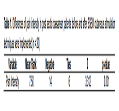Cutaneous stimulation of slow stroke back massage to reduce the pain of sectio caesarea

Downloads
Background: Labor with sectio caesarea may result to an impact after surgery, namely pain. The pain reduction technique that can be done is cutaneous stimulation of Slow Stroke Back Massage.
Objective: This study aims to determine cutaneous stimulation  of Slow Stroke Back Massage towards pain in post sectio caesarean patients
Methods: This study used Pre Experimental Design with the One-Group Pretest-Posttest Design approach. The samples studied were 20 patients of post SC surgery by consecutive sampling technique. The instrument used a VAS scale observation sheet. The research data were analyzed through Wilcoxon test.
Results: The results showed that the average pain intensity before the intervention was 6.10, the average intensity of pain after the intervention implemented reached 3.90, there was a difference of pain intensity in post sectio caesarean patients before and after cutaneous stimulation technique of Slow Stroke Back Massage (p-value = 0.001)
Conclusion: there is an effect of cutaneous stimulation of Slow Stroke Back Massage on pain in post sectio caesarean patients.Authors retain copyright and grant the journal right of first publication with the work simultaneously licensed under a Creative Commons Attribution-NonCommercial 4.0 International License that allows others to share the work with an acknowledgement of the work's authorship and initial publication in this journal.
Authors are able to enter into separate, additional contractual arrangements for the non-exclusive distribution of the journal's published version of the work (e.g., post it to an institutional repository or publish it in a book), with an acknowledgement of its initial publication in this journal.
Authors are permitted and encouraged to post their work online (e.g., in institutional repositories or on their website) prior to and during the submission process, as it can lead to productive exchanges, as well as earlier and greater citation of published work (See The Effect of Open Access).

This work is licensed under a Creative Commons Attribution-NonCommercial 4.0 International License.











